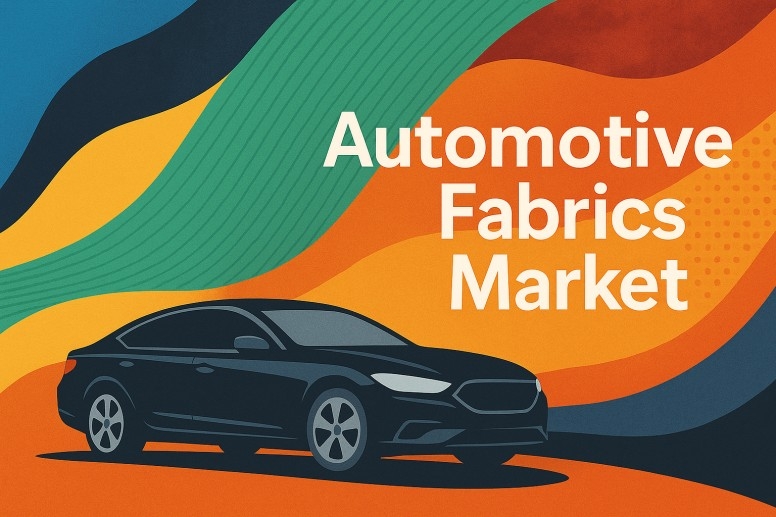Automotive Fabrics Market 2025 | Present Scenario and Growth Prospects 2035

The global automotive fabrics market is projected to grow steadily, rising from USD 39,776.3 million in 2025 to approximately USD 56,652.9 million by 2035, at a CAGR of 3.6%. This growth reflects a shift in consumer expectations, the rising popularity of electric and autonomous vehicles, and continuous innovation in textile technologies.
The automotive industry has long been driven by innovation, with advancements in engineering, technology, and design shaping consumer experiences on the road. While engines and electronics often dominate headlines, another critical area of transformation lies within the fabrics used in vehicles. Automotive fabrics have evolved far beyond basic upholstery, becoming integral to safety, comfort, sustainability, and aesthetics.
Discover Growth Opportunities in the Market – Get Your Sample Report Now
https://www.futuremarketinsights.com/reports/sample/rep-gb-4277
Automotive fabrics refer to specialized textiles and materials designed for use within vehicles. Unlike traditional fabrics, these materials are engineered to deliver functionality beyond aesthetics. They are integrated into seating, roof liners, carpets, door trims, airbags, and safety belts to provide durability, breathability, UV resistance, and thermal regulation.
With growing consumer demand for luxury-like interiors even in mid-segment vehicles, automotive fabrics are increasingly becoming a critical differentiator in the automotive industry.
Expanding Role of Automotive Fabrics in Vehicle Interiors
Automotive fabrics are no longer limited to seat coverings they have become integral to multiple components of modern vehicles. From roof liners and carpets to door trims and safety systems, fabrics influence not only aesthetics but also comfort, functionality, and performance.
Manufacturers are increasingly leveraging fabrics to create interiors that balance luxury with durability. This shift is driven by consumers seeking interiors that reflect both lifestyle and practicality. The demand for fabrics that are breathable, UV-resistant, and wear-resistant has grown, particularly in regions with harsh climates and for vehicles used in long-haul transport.
Passenger Comfort as a Central Growth Driver
The automotive industry has reached a point where comfort is as critical as performance. Vehicle buyers—whether in the luxury or mid-range segments are placing greater importance on features such as temperature regulation, softness, and tactile appeal.
High-quality fabrics play a pivotal role in meeting these expectations. For instance, breathable materials prevent heat buildup during long drives, while advanced textiles provide cushioning and ergonomic benefits that enhance passenger well-being. This trend is expected to intensify as urbanization and long commutes drive consumer preference for vehicles that feel like mobile living spaces.
Electric and Autonomous Vehicles: Catalysts for Fabric Innovation
The rise of electric vehicles (EVs) and autonomous cars is reshaping fabric requirements altogether. Unlike conventional vehicles, EVs require materials that support lightweight design, acoustic dampening, and thermal regulation to maximize efficiency and passenger comfort.
Fabrics with sound absorption properties are becoming indispensable in EV interiors, as electric drivetrains are quieter, highlighting external noise. Similarly, thermal management fabrics help regulate cabin temperature while reducing energy loads on the battery, directly influencing vehicle range. For autonomous vehicles, which emphasize passenger experience over driving, fabrics with superior aesthetics, durability, and modularity are gaining traction.
Sustainability and the Shift Toward Eco-Friendly Fabrics
One of the most significant transformations in the automotive fabrics industry is the shift toward sustainability. Increasing environmental concerns and government regulations are encouraging automakers to adopt recycled, bio-based, and eco-friendly fabrics.
For instance, recycled polyester, organic cotton blends, and plant-based leathers are being incorporated into car interiors, appealing to eco-conscious consumers. Additionally, circular economy initiatives are pushing manufacturers to design fabrics that are not only sustainable during production but also recyclable at the end of the vehicle’s life cycle.
Competitive Landscape
The competitive landscape of the automotive fabrics market is defined by innovation, sustainability, and partnerships. Global players are continuously collaborating with automakers to develop advanced materials that align with the industry’s evolving requirements.
Key Players
- Milliken & Company
- Autoliv
- Seiren Co., Ltd.
- Auto Textile S.A.
- Sage Automotive Interiors
- Benecke‑Kaliko (ContiTech)
- Toyota Boshoku
- Adler Pelzer Group (APG)
- Global Safety Textiles (GST)
- Parishudh Fibres Private Limited
Automotive Fabrics Market Segmentation
The Automotive Fabrics Market can be segmented based on:
By Product Type:
- Woven Fabric
- Non woven Fabric
- Knitted Fabric.
By Sales Channel:
- OEM and Aftermarket.
By Application:
- Airbags
- Floor Covering
- Belts & Hoses
- Tires
- Car Roof
- Safety-Belts
- Pre-Assembled Interior Component (PRIC)
- Upholstery
- Others.
By Vehicle Type:
- Compact Passenger Cars
- Mid-Sized Passenger Cars
- Light Commercial Vehicles
- Heavy Commercial Vehicles
- Others
By Region:
- North America
- Eastern Europe
- Western Europe
- East Asia
- South Asia Pacific
- Latin America
- Middle East & Africa
Checkout Now to Access Market Report:
https://www.futuremarketinsights.com/checkout/4277
About Future Market Insights (FMI)
Future Market Insights, Inc. (ESOMAR certified, recipient of the Stevie Award, and a member of the Greater New York Chamber of Commerce) offers profound insights into the driving factors that are boosting demand in the market. FMI stands as the leading global provider of market intelligence, advisory services, consulting, and events for the Packaging, Food and Beverage, Consumer Technology, Healthcare, Industrial, and Chemicals markets. With a vast team of over 400 analysts worldwide, FMI provides global, regional, and local expertise on diverse domains and industry trends across more than 110 countries.
- Questions and Answers
- Opinion
- Motivational and Inspiring Story
- Technology
- True & Inspiring Quotes
- Live and Let live
- Focus
- Art
- Causes
- Crafts
- Dance
- Drinks
- Film/Movie
- Fitness
- Food
- Spiele
- Gardening
- Health
- Startseite
- Literature
- Music
- Networking
- Andere
- Party
- Religion
- Shopping
- Sports
- Theater
- Wellness
- News
- Culture

